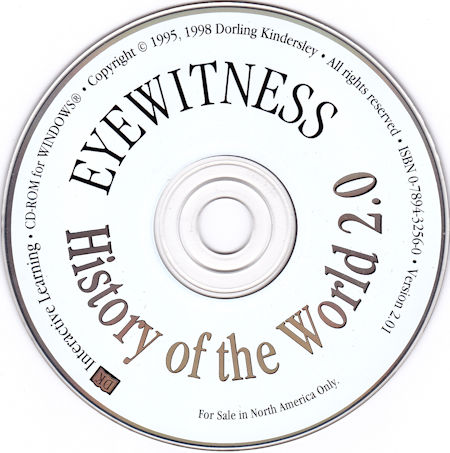
Actual Game
Eyewitness History
|
The Game
Superficially, Eyewitness History of the World 2.0 is an encyclopedia of world history. But it is much more than just an encyclopedia.
When one sits down to use the program, in a few minutes he or she can examine a computer-generated replica of a World War II era British Spitfire as it flies past the screen or tour the acropolis at Athens. There are real film clips as well of Pearl Harbor ablaze after the Japanese attack in December 1941 as well as battle scenes from World War I's Western Front. If art is the reader's interest, fine Persian rugs can be found as well as Chinese silk painting and Roman mosaics.
In fact, the striking thing about Eyewitness is there are so many options to view information. Films, audio features, computer-generated graphics, pictures, maps and sound effects all provide avenues of learning in the program.
Each time the viewer opens a new window of information the program teases him or her on to something else. Open the multi-layered format on the Fujiwara clan of Japan and a recording will sound out its importance to medieval Japanese history while providing a period painting of the Tale of Genji, the 11th century sotry written by Lady Murasaki. Press another button and learn more about the role of women in the area, or about the Japanese Samurai, or the Tea Ceremony, and onward.
After mastering the interface, the viewer can quickly begin another journey. For example, start with the slave trade. Soon an 18th century diagram of the crowded interior of a slave ship will appear and an eyewitness will read from the diary of a British Naval Officer. Click another button and find an account of the triangular trade of the era between Africa, the Americas and Europe. Or join Cortez and the Spanish as they enter the Aztec capital of Tenochtitlan in 1519 and hear the eyewitness account by Diaz del Castillo. I particularly liked a section on ancient Mediterranean trade that provided separate maps for Phoenician and Mycenaean trade routes.
In the category of documents, the viewer can see a copy of Chairman Mao's Red Book, Jewish identity tags from the Nazi regime, drawings done by Leonardo Da Vinci, or hear poetry by the Chinese 7th century poet Li Po while seeing a period painting of the man. There are other categories of culture, innovations, and everyday life that offer ample illustrations and descriptions of their subjects. A Who's Who section provides a great many biographical sketches of important individuals.
In addition to parts of the program that contain the audio/visual features, a significant part of the program provides substantial textual material about various subjects for those who want to obtain more in depth information. This is particularly true of country histories.
There are two games connected with the program. One, probably designed for younger users, is a quiz that forces one to search through the various avenues of information for the correct answers. It seems a clever way to get youngsters to dig through the material. Both of the games encourage learning from the program for young and old.
The program is mainly designed to be a family resource and is highly recommendable for that purpose. It would be especially good for students who are trying to learn more about history.












